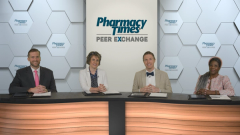
Barriers to Optimal RSV Vaccination Rates
Financial, clinical, and social barriers to adult RSV vaccination are explored.
Episodes in this series

Ryan Haumschild, PharmD, MS, MBA: Everyone knows that as we’re developing different vaccination strategies, we have to be proactive in addressing barriers because they exist across all patient types and a lot of diseases. Dr Welch, when we think about RSV [respiratory syncytial virus], what are the potential obstacles that we have related to administration, such as antigenic groups or even payer coverage?
Adam C. Welch, PharmD, MBA, FAPhA: This is an interesting, timed vaccine as far as the approval. The FDA approved the first RSV vaccine in older adults in May. ACIP [Advisory Committee on Immunization Practices] talked about it in June. RSV season seems to resemble flu season, which is in October. Will we be ready to target those vulnerable adults, age 60 and older, come this RSV season? We’re not sure. It’s going to require a lot of entities to come on board and recognize the importance of RSV prevention through vaccines.
Payers will include coverage for vaccines once the ACIP recommendations are published in the Morbidity Mortality Weekly Report [MMWR]. It could take several months for the CDC [the Centers for Disease Control and Prevention] to take the ACIP recommendations, formulate the publication, and get it out there. But in a couple of months, we’ll be knee-deep in RSV season and influenza season. We might miss that window unless payers react before the MMWR publication comes out. They have the tools they need to make that decision because the phase 3 trials for these vaccines have been published in the New England Journal of Medicine. The meetings of discussion from the FDA and the CDC are out there. Payers have the tools they need to make the decisions to cover these vaccines. It’s just a matter of getting all those aligned so we can have vaccines ready to go and be paid for, and the pharmacist ready to inject them come this RSV season.
Christina Madison, PharmD, FCCP, AAHIVP: I want to reiterate that those meetings are all public. If you’re like me—a vaccine nerd who watches the ACIP meetings live—you can see them. Although they may not be published until January or February, because that’s when they come out every year, those recommendations are finalized by the end of that last meeting. Usually, they meet again in August, and all those recommendations are finalized. We need to emphasize that, from a payer standpoint, the data are there. Let’s try to avoid another crisis like last year, when we saw all those unnecessary deaths.
Adam C. Welch, PharmD, MBA, FAPhA: What practitioners can do now is plant the seed. We’re going to see our patients succeed. We’re going to see our patients with heart failure and COPD [chronic obstructive pulmonary disease] and start talking to them: “There’s an RSV vaccine out. What questions do you have? This is what it does. This is what it prevents.” Health systems can begin looking at their triage policies and say, “If they come in with these criteria—age based or certain conditions—then we need to think about RSV vaccines.” As providers, we can put those policies in place and plant those seeds in our patients so that when the vaccine is available and paid for, it will be an easier sell to patients.
Christina Madison, PharmD, FCCP, AAHIVP: [We can do that] from an entry standpoint but also [in terms of] discharge, planning, and transitions of care. If somebody is going to be discharged into 1 of these facilities that may put them at a higher risk for being exposed to RSV, should we be thinking—as far as discharge planning—that they should be looked at for vaccination if they’re age 60 or older?
Adam C. Welch, PharmD, MBA, FAPhA: Now it the time.
Ryan Haumschild, PharmD, MS, MBA: I like the concept you described as engaging the patient and discharge planning the payers. It’s that shared decision-making framework and making the patient the center of that so they have clear expectations of what’s coming and the benefits. Then when we have access, we can create a smooth transition for that patient.
Transcript edited for clarity.
Newsletter
Stay informed on drug updates, treatment guidelines, and pharmacy practice trends—subscribe to Pharmacy Times for weekly clinical insights.


